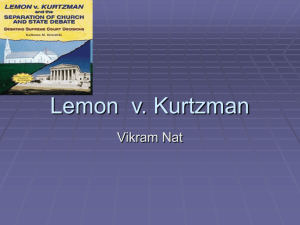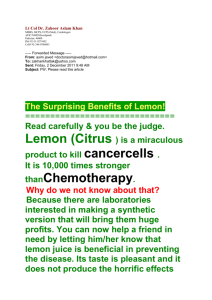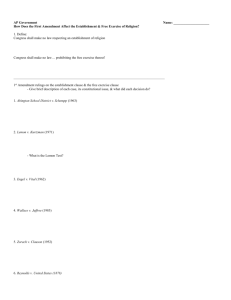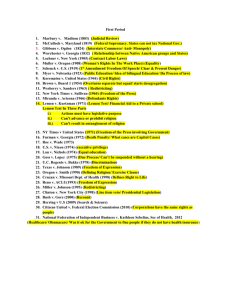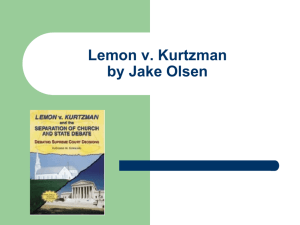Document 14120519
advertisement
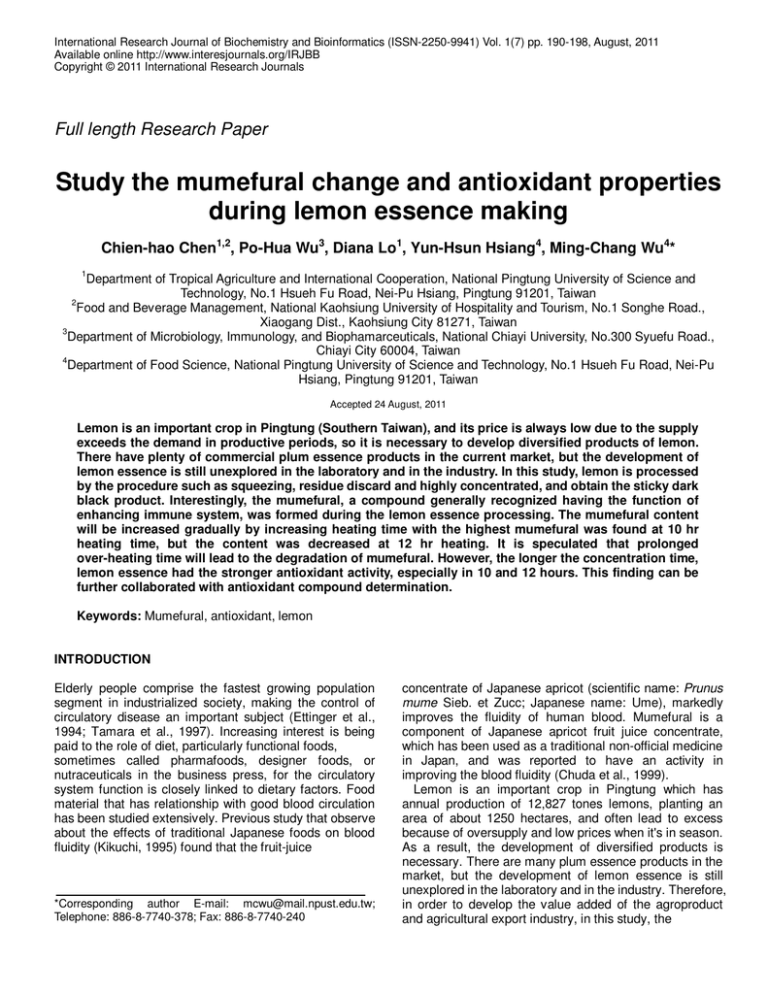
International Research Journal of Biochemistry and Bioinformatics (ISSN-2250-9941) Vol. 1(7) pp. 190-198, August, 2011 Available online http://www.interesjournals.org/IRJBB Copyright © 2011 International Research Journals Full length Research Paper Study the mumefural change and antioxidant properties during lemon essence making Chien-hao Chen1,2, Po-Hua Wu3, Diana Lo1, Yun-Hsun Hsiang4, Ming-Chang Wu4* 1 Department of Tropical Agriculture and International Cooperation, National Pingtung University of Science and Technology, No.1 Hsueh Fu Road, Nei-Pu Hsiang, Pingtung 91201, Taiwan 2 Food and Beverage Management, National Kaohsiung University of Hospitality and Tourism, No.1 Songhe Road., Xiaogang Dist., Kaohsiung City 81271, Taiwan 3 Department of Microbiology, Immunology, and Biophamarceuticals, National Chiayi University, No.300 Syuefu Road., Chiayi City 60004, Taiwan 4 Department of Food Science, National Pingtung University of Science and Technology, No.1 Hsueh Fu Road, Nei-Pu Hsiang, Pingtung 91201, Taiwan Accepted 24 August, 2011 Lemon is an important crop in Pingtung (Southern Taiwan), and its price is always low due to the supply exceeds the demand in productive periods, so it is necessary to develop diversified products of lemon. There have plenty of commercial plum essence products in the current market, but the development of lemon essence is still unexplored in the laboratory and in the industry. In this study, lemon is processed by the procedure such as squeezing, residue discard and highly concentrated, and obtain the sticky dark black product. Interestingly, the mumefural, a compound generally recognized having the function of enhancing immune system, was formed during the lemon essence processing. The mumefural content will be increased gradually by increasing heating time with the highest mumefural was found at 10 hr heating time, but the content was decreased at 12 hr heating. It is speculated that prolonged over-heating time will lead to the degradation of mumefural. However, the longer the concentration time, lemon essence had the stronger antioxidant activity, especially in 10 and 12 hours. This finding can be further collaborated with antioxidant compound determination. Keywords: Mumefural, antioxidant, lemon INTRODUCTION Elderly people comprise the fastest growing population segment in industrialized society, making the control of circulatory disease an important subject (Ettinger et al., 1994; Tamara et al., 1997). Increasing interest is being paid to the role of diet, particularly functional foods, sometimes called pharmafoods, designer foods, or nutraceuticals in the business press, for the circulatory system function is closely linked to dietary factors. Food material that has relationship with good blood circulation has been studied extensively. Previous study that observe about the effects of traditional Japanese foods on blood fluidity (Kikuchi, 1995) found that the fruit-juice *Corresponding author E-mail: mcwu@mail.npust.edu.tw; Telephone: 886-8-7740-378; Fax: 886-8-7740-240 concentrate of Japanese apricot (scientific name: Prunus mume Sieb. et Zucc; Japanese name: Ume), markedly improves the fluidity of human blood. Mumefural is a component of Japanese apricot fruit juice concentrate, which has been used as a traditional non-official medicine in Japan, and was reported to have an activity in improving the blood fluidity (Chuda et al., 1999). Lemon is an important crop in Pingtung which has annual production of 12,827 tones lemons, planting an area of about 1250 hectares, and often lead to excess because of oversupply and low prices when it's in season. As a result, the development of diversified products is necessary. There are many plum essence products in the market, but the development of lemon essence is still unexplored in the laboratory and in the industry. Therefore, in order to develop the value added of the agroproduct and agricultural export industry, in this study, the Chen et al. extracted lemon juice was used, heated by the time interval and mumefural content and antioxidant ability were observe to show the special function of produced lemon essence, and hopefully it will be able to help lemon farmers increasing their income, and contribute to farmers and the social-economic of the agricultural areas (Sun, 2008). MATERIALS AND METHODS 191 Kaneda, 1985). Water activity was measured by loading sample into the water activity meter (AQUALAB CX-2, Washington, USA) and measured at room temperature with 3 times repetition for each sample. Water content was determined using infra-red moisture meter (FD 600, KETT, Japan) by comparing weight before and after heat treatment at 102°C. Color value was determined by Hunter-Lab (TC-1500 DX, DENSOKU, Japan) which L represent lightness, a represent red (+) and green (-) color, and b represent yellow (+) and blue (-) color. Materials Eureka full-ripen lemon fruit (± 85 gram/piece) were collected from Lemon Production and Marketing Cooperation, Jiu Ru Village, Pingtung County, Taiwan. Japanese apricot were obtained from Nakano BC. Co. Ltd, Japan. Chemical reagent including Folin-Ciocalteu’s phenol reagent, 1,1-diphenyl-2-picryl-hydrazyl (DPPH), 5-hydroxylmethyl-2-furaldehyde (HMF), and 22’-azinobis[3-ethylbenzoth iazoline-6-sulfonic acid] (ABTS) were purchased from Sigma, USA. Other chemical reagents used were in analytical grade. Methods Lemon Essence Production About 50 pieces of fresh lemon were extracted using juice extractor to obtain about 1900 mL lemon juice. Filtered lemon juice were in directly boiled in a pottery pot using small fire, with temperature was about 97-100°C, and stirred constantly by mixing stick to prevent the bottom overheating. Sampling was taken at time of 0, 2, 4, 6, 8, 10, and 12 hours (Nakamura, 1995). After concentrated, lemon essence was freeze dried (PANCHUM FD-5030, Taiwan) and it will be diluted based on concentration for analysis. Physiological properties determination During boiling time to obtain lemon essence, several physicochemical properties was determined; including total soluble solids, titratable acidity, water activity (Aw), water content, ascorbic acid content, color determination, and change in viscosity. Total soluble solid was determined by placing small amount of lemon essence into top of prism of Abbe refractometer (Tokyo, Japan), close the daylight plate and brix degree could be seen on the scale. Titratable acidity (organic acid content) was determined by titration of 0.3 grams sample in 100 mL distilled water with 0.1 N NaOH solution with phenolphthalein as color indicator. The titratable acidity value (%) was calculated as following: 0.1N NaOH (mL) × 0.0070055/Sample weight (g) *100 (Hatanaka and Citric acid, malic acid, HMF and mumefural contents determination HMF, mumefural, citric acid and malic acid contents were determined by HPLC (HITACHI UV detector L-7400, Japan). Sample was prepared by adding 0.3 grams lemon essence with distilled water until 10 mL, shocked with ultrasound for 10-15 minutes and centrifuged at 6000 rpm for 10 minutes. After centrifugation, 0.5 mL supernatant was collected into the SPF column (add 1.5mL distilled water), and added 1.5. mL acetonitrile CH3CN, then the filtrate were collected and some sample was filtered with 0.2 µm small filter before HPLC analysis (Chuda et al., 1999). HPLC used in citric acid and malic acid content determination were using YMC-Pack AQ-303 column with S-5 µm, 250×4.6 mm. The flow rate was 0.7 ml min−1. Amount of 10 µl test solution were injected into the system and the spectra was recorded at 280 nm with UV detector. The mobile phase used was 0.1 M of ammonium phosphate monobasic buffer pH 2.0 (Huang et al., 2002). HPLC analysis for HMF and mumefural were established using XTerraTM MS C18 column with 3.5 µm 2.1×150 mm (WATERS, USA). The temperature of the column oven was set at 45 °C. The flow rate was 1.2 ml min−1. Amount of 2 µl test solution were injected into the system and the spectra was recorded at 280 nm with UV detector. The mobile phase used was explained in Table 1 (Chuda et al., 1999). Antioxidant compound determination Total phenolic compound determination Total phenolic content were determined by following Chu et al. (2002) method. Filtered lemon essence (0.2 mL) was added with distilled water until 2 mL and 1 mL of Folin-Ciocalteu’s Phenol reagent were added. After 3 minutes reaction time, 0.8 mL of 20% Na2CO3 was added and reacted again for 30 minutes. Absorbance was measured in 740 nm using spectrophotometer. Gallic acid (225-350 ppm) was used as standard and total phenolic contents were expressed as µg gallic acid equivalent/g 192 Int. Res. J. Biochem. Bioinform. Table 1: The mobile phase of HMF and mumefural determination by HPLC Time (min) 0 10 20 30 40 50 60 Acetonitrile (%) 0 2 4 6 4 2 0 sample. Total flavonoid determination The total flavonoid content of the samples was measured using colorimetric method (Abeysinghe et al., 2007). Filtered lemon essence (0.5 ml) was added to a test tube containing 1.5 ml of absolute ethanol. After addition of 0.1 mL 1 M Al(NO3)3, 0.1 mL 1 M CH3COOK, and 2.8 mL of distilled water. Absorbance was measured at 420 nm using spectrophotometer after 30 min reaction time. Quercetin (0-100 ppm) was used as the standard and total flavonoid contents were expressed as µg quercetin equivalents/g sample. Vitamin C content determination Vitamin C determination was done by following Gil et al. (2002) with modification. Three grams of sample was added with 0.5% oxalic acid until 100 mL and reacted for 5-10 minutes. Amount of 20 mL reaction mixture were collected into tube, added with half-spoon of activated carbon and mixed well by ultrasonic bath (BRANSON 8210, Japan). After filtered, the liquid layer was transferred into a flask and 3.5 mL of liquid phase were added with oxalic acid until 4 mL. Reaction started with addition of 0.1 and 1 mL of 2,4-dinitrophenylhydrazine (DNP) and incubated in hot water for 10 minutes. After cooling down, 5 mL of 85% H2SO4 solution was added and absorbance was measured in O.D 515 nm. Vitamin C contents were calculated from ascorbic acid standard curve. Antioxidant activity determination DPPH free radical scavenging activity DPPH free radical scavenging activity was determined according to Mensor et al. (2001). Freeze dried lemon essence were added with appropriate amount of distilled water for preparation of 250, 125, 62.5, 31.25, 15.63, 9, 6, Sodium phosphate buffer pH 2.3 (%) 100 98 96 94 96 98 100 3, 1 mg/mL sample concentration. Taking 4 mL of various concentrations of samples and then adding 1 mL of 1 mM DPPH solution. Distilled water was use to replace sample in control. After shaking at room temperature for 30 minutes, absorbance of the sample were measured in 517 nm using HITACHI U-2001 spectrophotometer (Tokyo, Japan) and the DPPH free radical scavenging capacity was expressed in % with formula: (abs control - abs sample)/abs control x 100. TEAC (Trolox Equivalent Antioxidant Activity) TEAC was determined by comparing ABTS free radical-scavenging activity of each sample according to the method described by Re et al. (1999). The radical cation ABTS· + was generated by persulfate oxidation of ABTS. A mixture (1:1, v/v) of ABTS (7.0 mM) and potassium persulfate (4.95 mM) was allowed to stand overnight (12-16 hours) at room temperature in the dark to form radical cation ABTS· +. A working solution was diluted with phosphate buffer solution to absorbance values 0.7±0.02 at 734 nm. An aliquot (0.01 ml) of each sample was mixed with the working solution (1 ml), and the decrease of absorbance was measured at 734 nm after 1 minute. Aqueous phosphate buffer solution (1 ml, + without ABTS· solution) was used as a control. The + ABTS· scavenging rate was calculated as mmol trolox equivalent antioxidant activity/g sample. Reducing power The ability to reduce ferric ions was measured using method described by Yen and Chen (1995). An aliquot (150 µL) of each sample was added with 0.2 M sodium phosphate buffer and 1% K3Fe(CN)6 with the same solution amount and the reaction mixture was incubated at 50°C for 20 min. After cooled down for 3 minutes in ice water, 150 µL 10% TCA, 0.6 mL distilled water and 120 µL 0.1% FeCl3 were added and reacted for 14 minutes. Absorbance value was measured at 700 nm by spectrophotometer. Higher absorbance show higher reducing power. Chen et al. 193 Figure 1: The changes of total soluble solids and titratable acidity in different heating time during lemon essence processing. Data expressed as mean ± SD (n=3). Superoxide anion scavenging activity The effect of scavenging superoxide radical was determined by the nitroblue tetrazolium reduction method (Robak and Gryglewski, 1988). Reagent such as 120 µM phenazine methosulfate (PMS), 936 µM nicotinanamide adenine-dinucleotide (NADH) and 300 µM nitroblue tetrazolium (NBT) were prepared by diluting with 0.1 M PBS (pH 7.4). Sample about 0.3 mL were added with 1 mL each of PMS, NADH, and NBT, reacted for 5 minutes and measured in 560 nm spectrophotometer against blank samples, containing all the reagents except the PMS. The lower absorbance value shows the higher scavenging activity. Superoxide radical scavenging activity was expressed in % with formula: (1-(abs sample/abs control)) x 100 Statistical analysis Statistical analyze was done by using Statistical Analysis System (SAS). Statistical analyze that conducted was analysis of variance (ANOVA) using Duncan’s multiple range comparison post hoc with p<0.05 considered significant. RESULTS Physiological Properties determination The average soluble solids of fresh lemon juice is about 7.5°Brix. This Brix value is greater than 6.5 of lime CNS (Chinese National Standard). Soluble solids were increased by the heating time and significant increases were observed at 9-12 hours processing (Figure 1). After 12 hours heating time, Brix value was 82°Brix. The titratable acid also increased during the time heating and obvious changes were found in 9-12 hours. This phenomenon was the similar as the change of total soluble solid. The moisture content of lemon juice was decreased by the processing time. It was just a small change in the water activity (Aw) value during 0 to 11 hours, but after 11 hour heating time, Aw value was drop from 0.88 until 0.4 (Figure 2). Lower Aw could be applied for food preservation Water content value also decrease as the increase of heating time and obvious decrease was shown in 9-12 hours heating time. Color value determination results were shown in Table 2. Lightness of lemon juice was decease as the increase of processing time. After 9 hours processing time, lemon essence change the color become reddish and this color intensity increase as the increase of processing time. Generated reddish color may due to maillard reaction occur in lemon essence processing. Citric acid, malic acid, HMF and mumefural contents determination Citric acid, malic acid, and HMF content were determined 2 by comparison with standard curve (r >0.995). The content of citric acid and malic acid, non-volatile acid, on lemon essence (based on the original water content) during the heating processing were fluctuated as shown in Figure 3. These acids content in lemon essence showed tendency to decrease as processing time increase. Both 194 Int. Res. J. Biochem. Bioinform. Figure 2: The changes of Aw and moisture content in different heating time during lemon essence processing. Data expressed as mean ± SD (n=3). Table 2: Change in color L, a, b value of lemon essence processing Hour 0 1 2 3 4 5 6 7 8 9 10 11 12 L 49.425 ± 0.063a 47.655 ± 0.007c 43.65 ± 0.035h 47.285 ± 0.021d 42.225 ± 0.042k 48.035 ± 0.007b 45.28 ± 0.028f g 45.04 ± 0.042 45.55 ± 0.014e 42.905 ± 0.077j 43.25 ± 0.028i 16.355 ± 0.021l 6.267 ± 0.056m a -3.735 ± 0.063i -3.08 ± 0.014h -3.21 ± 0.007h -2.415 ± 0.049g -2.415 ± 0.063g -1.45 ± 0.028e -1.66 ± 0.035f e -1.29 ± 0.056 -1.085 ± 0.021d 0.145 ± 0.035e 1.353 ± 0.410b 1.67 ± 0.056b 7.225 ± 0.162a Each value is expressed as mean ± SD (n=3). indicate the significant difference (p<0.05). b 9.05 ± 0.014k 12.745 ± 0.098i 11.225 ± 0.007j 14.115 ± 0.035g 12.995 ± 0.021h 15.64 ± 0.014d 14.805 ± 0.007f e 15.03 ± 0.021 15.7 ± 0.0035c 16.075 ± 0.007b 17.21 ± 0.014a 8.545 ± 0.021l 2.273 ± 0.056m a-l Values in column with different superscript Figure 3: Citric acid and Malic acid contents during in different heating time during lemon essence processing. Data expressed as mean ± SD (n=3). Chen et al. 195 Figure 4: HPLC Chromatograms (280 nm) of HMF and mumefural contents during the different time processing of lemon essence. Figure 5: Total phenolic content of lemon essence processing. Data expressed as mean ± SD (n=3). of these acids were detected have low contents in 10 hour processing time and become higher again after that time. HMF was produced after heating for 2 hours. The longer the heating time, the higher HMF content (Figure 4). HMF showed highest content on heating 10 hours (1.3 mg/g) and reduced at 12 hour processing time (1.0 mg/g). There was no mumefural content in early processing time (2 hours). The mumefural content increased slowly as heating time increase (4-8 hours). The significant production of mumefural was exhibit in 10 hours processing time, and its content reduced again at 12 hours processing time. Antioxidant compound determination Antioxidant compound that determined were total phenolic and flavonoid content and vitamin C compound for every hour processing time. Flavonoid is one group compound that included as phenolic compounds. Result shown in Figure 5 and 6 demonstrated that total phenolic and flavonoid contents were increased as the increase of processing time and total flavonoid content increased most at 12 hours heating time. Different with phenolic and flavonoid contents, vitamin C content decrease by the processing time (Figure 7). Antioxidant activity determination This result also showed that produced lemon essence have antioxidant activity. Antioxidant activities measured in this study were DPPH free radical scavenging activity, TEAC (Trolox Equivalent Antioxidant Activity), reducing 196 Int. Res. J. Biochem. Bioinform. Figure 6: Total flavonoid content of lemon essence processing. Data expressed as mean ± SD (n=3). Figure 7: Total vitamin C content of lemon essence processing. Data expressed as mean ± SD (n=3). power and superoxide anion scavenging activity. Figure 8 showed that there are no significant difference of DPPH free radical scavenging ability difference between lemon essence and Japanese apricot essence. All antioxidant activities showed that there are increase in antioxidant properties as increasing processing time and concentration (Figure 9). Superoxide anion scavenging ability showed higher percentage compared to DPPH free radical scavenging ability. In TEAC and reducing power, lemon essence at 10 and 12 hour processing showed significantly higher antioxidant properties compared with other processing time. DISCUSSION In this study, lemon is processed by a series of squeezing, residue removal and highly concentrated, and the sticky dark black product was achieve (Huang, 1986) as shown on its physiological properties. Physiological properties of lemon essence product after 12 hours heating time were higher in Brix value, titratable acidity (organic compounds), reddish color and lower water content, Aw, and lightness value, as compared to lemon juice (before concentrated). HMF, often used as an index of heat treatment and deteriorative changes in food such as tomato paste, infant milk, honey, and fruit juices, was resulted from Maillard reaction (Hurtado et al., 1998; Vinas et al., 1992). The present study demonstated HMF formation as heating time increased as the result of mailard reactions. Mumefural compound is a compound generally recognized having the function of enhancing immune system. Mumefural was synthesized by equal molecules of citric acid and HMF (Chuda et al., 1999). Reduced citric Chen et al. Figure 8: DPPH scavenging activity of lemon essence compared with Japanese apricot essence and vitamin C. Data expressed as mean ± SD (n=3). a-c Values with different superscript indicate the significant difference (p<0.05). a c b d Figure 9: Antioxidant properties of lemon essence (a) DPPH scavenging activity, (b) TEAC, (c) reducing power, and (d) superoxide anion scavenging activity. Data expressed as mean ± SD (n=3). a-h Values with different superscript indicate the significant difference (p<0.05). 197 198 Int. Res. J. Biochem. Bioinform. acid content in 10 hour processing time may due to its usage as substrate for mumefural formation. There is no mumefural presence in the fresh lemon juice. The mumefural content will be increased gradually by increasing heating time with the highest mumefural was found at 10 hr heating time, but the content was decreased at 12 hr heating. It is speculated that prolonged over-heating time will lead to the degradation of mumefural. Interestingly, the longer the concentration time, lemon essence had the stronger antioxidant activity, especially in 10 and 12 hours. This finding can be further collaborated with antioxidant compound determination. Antioxidant compound that may interfere with antioxidant properties were phenolic, especially flavonoid compound as shown increase as the increase of heating time. According to the report, that antioxidant power of food is not necessarily because of thermal processing could be decreased or loss of power (Nicoli et al. 1999). In some cases, that certain processed food antioxidant capacity could be increased by heating, may be related to the generation of browning products. (Nicoli et al. 1997; Anese et al. 1999). Therefore, HMF and mumefural also suspected as compounds that played important role in antioxidant properties of lemon concentrated product. REFERENCES Abeysinghe DC, Li X, Sun C, Zhang W, Zhou C, Chen K (2007). Bioactive compounds and antioxidant capacities in different edible tissue of citrus fruit of four species. Food chem. 104: 1338-44. Anese M, Manzocco L, Nicoli M, Lerici CR (1999). Antioxidant properties of tomato juice as affected by heating. J. the Sci. of Food and Agricul. 9: 750-4. Chu YF, Sun J, Wu X, Liu RH (2002). Antioxidant and antiproliferative activities of common vegetables. J. Agricultural and Food Chem. 50: 6910-6. Chuda Y, Ono H, Ohnishi-Kameyama M, Matsumoto K, Nagata T, Kikuchi Y (1999). Mumefural, citric acid derivative improving blood fluidity from fruit-juice concentrate of Japanese apricot (Prunus mume Sieb. et Zucc). Journal of Agricultural and Food Chemistry 47: 828-831. Ettinger W.H, Fried LP, Harries T, Shemanski L, Schulz R, Robbins J (1994). Self-reported causes of physical disability in older people: cardiovascular health study. J. Am. Geriatr. Soc 42: 1035-1044. Gil MI, Tomás-Barberán FA, Hess-Pierce B,Kader AA (2002). Antioxidant capacities, phenolic compounds, carotenoids, and vitamin C contents of nectarine, peach, and plum cultivars from California. J. Agricul. and Food Chem. 50: 4976–82. Hatanaka H, Kaneda Y (1985). Food hygienic investigation on Japanese apricot extract. J. the Food Hygienic Society of Japan 26: 350-356. Huang TC (1986). Pigment composition and color changes during processing of mei (plum). Role of chemistry in the quality of processed food. Food and Nutrition Press. Westport U.S.A. 108 - 111. Huang WS, Lin CC, Huang MC, Wen KC. 2002. Determination of α-hydroxyacids in cosmetics. Journal of Food and Drug Analysis 10: 95-100. Hurtado S.A, Nogues MTV, Font AM, Carou MCV (1998). Changes in furfural compounds during storage of infant milks. J. Agric. Food Chem. 46: 2998-3003. Kikuchi Y (1995). Measurement of blood rheology by model capillaries and evaluation of effects of food components. Shokuhin to kaihatsu 30: 46-48. Mensor LL, Menezes FS, Leitao GG. Reis AS, Santos TC, Coube CS, Leitao SG (2001). Screening of brazilian plant extracts for antioxicant activity by the use of DPPH free radical method. Phytotherapy Res. 15: 127-130. Nakamura A (1995). Organic acids, free amino acids and sugars compositions in ume (Prunus mume) extract, and change of their component during preparation process of ume extract. Nippon Eiyo Shokuryo Gakkaish 48: 232-235. Nicoli MC, Anese M, Parpinel MT (1999). Influence of processing on the antioxidant properties of fruit and vegetables. Trends in Food Sci. and Technol. 10: 94-100. Nicoli MC, Anese M, Parpinel MT, Franceschi S (1997). Loss and/or formation of antioxidants during food processing and storage. Cancer Letters 114: 71-74. Re R, Pellegrini N, Protegente A, Pannala A, Yang M, Rice-Evans C (1999). Antioxidant activity applying in approved ABTS radical cation decolorization assay. Free Radical Biol. and Med. 26: 1231-7. Robak J, Gryglewski RJ (1988). Flavonoids are scavenger of superoxide anions. Biochem. Pharmacol. 37: 837-41. Sun CJ (2008). Change of Mumefural in Processed Mei-gin that Showed Hepatic Detoxification and Anti-tumor Action. Department of Food Science, National Pingtung Uni. of Sci. and Technol. Tamara BH, Peter JS, Grethe ST, Mary H., Shiriki K, James CL (1997). Carrying the burden of cardiovascular risk in old age: associations of weight and weight change with prevalent cardiovascular disease, risk factors, and health status in the Cardiovascular Health Study. Am. J. Clin. Nutr. 66: 837-844. Vinas P, Campillo N, Cordoba MH, Candela ME (1992). Simultaneous liquid chromatographic analysis of 5-(hydroxymethyl)-2-furaldehyde and methyl anthranilate in honey. Food Chem. 44: 67-72. Yen GC, Chen HY (1995). Antioxidant activity of various tea extracts in relation to their antimutagenicity. J. Agr. Food Chem. 43: 27–32.
